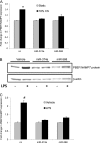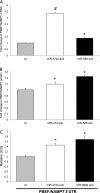Mechanical stress induces pre-B-cell colony-enhancing factor/NAMPT expression via epigenetic regulation by miR-374a and miR-568 in human lung endothelium
- PMID: 24053186
- PMCID: PMC3930953
- DOI: 10.1165/rcmb.2013-0292OC
Mechanical stress induces pre-B-cell colony-enhancing factor/NAMPT expression via epigenetic regulation by miR-374a and miR-568 in human lung endothelium
Abstract
Increased lung vascular permeability and alveolar edema are cardinal features of inflammatory conditions such as acute respiratory distress syndrome (ARDS) and ventilator-induced lung injury (VILI). We previously demonstrated that pre-B-cell colony-enhancing factor (PBEF)/NAMPT, the proinflammatory cytokine encoded by NAMPT, participates in ARDS and VILI inflammatory syndromes. The present study evaluated posttranscriptional regulation of PBEF/NAMPT gene expression in human lung endothelium via 3'-untranslated region (UTR) microRNA (miRNA) binding. In silico analysis identified hsa-miR-374a and hsa-miR-568 as potential miRNA candidates. Increased PBEF/NAMPT transcription (by RT-PCR) and expression (by Western blotting) induced by 18% cyclic stretch (CS) (2 h: 3.4 ± 0.06 mRNA fold increase (FI); 10 h: 1.5 ± 0.06 protein FI) and by LPS (4 h: 3.8 ± 0.2 mRNA FI; 48 h: 2.6 ± 0.2 protein FI) were significantly attenuated by transfection with mimics of hsa-miR-374a or hsa-miR-568 (40-60% reductions each). LPS and 18% CS increased the activity of a PBEF/NAMPT 3'-UTR luciferase reporter (2.4-3.25 FI) with induction reduced by mimics of each miRNA (44-60% reduction). Specific miRNA inhibitors (antagomirs) for each PBEF/NAMPT miRNA significantly increased the endogenous PBEF/NAMPT mRNA (1.4-3.4 ± 0.1 FI) and protein levels (1.2-1.4 ± 0.1 FI) and 3'-UTR luciferase activity (1.4-1.7 ± 0.1 FI) compared with negative antagomir controls. Collectively, these data demonstrate that increased PBEF/NAMPT expression induced by bioactive agonists (i.e., excessive mechanical stress, LPS) involves epigenetic regulation with hsa-miR-374a and hsa-miR-568, representing novel therapeutic strategies to reduce inflammatory lung injury.
Figures







References
-
- Levitt JE, Matthay MA. Treatment of acute lung injury: historical perspective and potential future therapies. Semin Respir Crit Care Med. 2006;27:426–437. - PubMed
-
- Rubenfeld GD, Caldwell E, Peabody E, Weaver J, Martin DP, Neff M, Stern EJ, Hudson LD. Incidence and outcomes of acute lung injury. N Engl J Med. 2005;353:1685–1693. - PubMed
-
- Ognjanovic S, Bao S, Yamamoto SY, Garibay-Tupas J, Samal B, Bryant-Greenwood GD. Genomic organization of the gene coding for human pre-b-cell colony enhancing factor and expression in human fetal membranes. J Mol Endocrinol. 2001;26:107–117. - PubMed
-
- Rongvaux A, Shea RJ, Mulks MH, Gigot D, Urbain J, Leo O, Andris F. Pre-b-cell colony-enhancing factor, whose expression is up-regulated in activated lymphocytes, is a nicotinamide phosphoribosyltransferase, a cytosolic enzyme involved in NAD biosynthesis. Eur J Immunol. 2002;32:3225–3234. - PubMed
Publication types
MeSH terms
Substances
Grants and funding
LinkOut - more resources
Full Text Sources
Other Literature Sources
Miscellaneous

